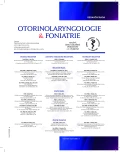„New Year´s“ Foreign Body in the Orbit
Authors:
M. Adásková 1,2; Marian Sičák 1,3
Authors‘ workplace:
Klinika otorinolaryngológie a chirurgie hlavy a krku ÚVN-FN Ružomberok
1; Slovenská zdravotnícka univerzita v Bratislave
2; Katolícka univerzita v Ružomberku
3
Published in:
Otorinolaryngol Foniatr, 68, 2019, No. 3, pp. 157-160.
Category:
Case Reports
Overview
The authors present a case report of a 37 years old patient who arrives at the Clinic of Otorhinolaryngology, Head and Neck Surgery in Ružomberok on the New Year. An extensive foreign body is located in the patient´s orbit - a Christmas tree branch 11 cm long. The foreign body penetrates the mediocaudal part of the orbit, passes through the orbital bottom into the maxillary cavity and to the deep retromaxillary space and ends in the infratemporal fossa. Eye bulb and optic nerve remain undamaged. In the case study, the authors describe CT images, surgical approach of extraction and its risks. They refer to necessity of early extraction of biological foreign body, emphasize the control of bleeding and point to cooperation with the ophthalmologist.
Keywords:
foreign body – orbit – eye injury
Sources
1. Asif, J. A., Pohchi, A., Alam, M. K. et al.: An intraorbital metallic foreign body. Indian J Ophthalmol, 62, 2014, 11, s. 1098-1100.
2. Cho, W. K., Ko, A. C., Eatamadi, H. et al.: Orbital and Orbitocranial Trauma From Pencil Fragments: Role of Timely Diagnosis and Management. Am J Ophthalmol, 180, 2017, s. 46-54.
3. Devaiah, A. K., Reiersen, D., Hoagland, T.: Evaluating endoscopic and endoscopic-assisted access to the infratemporal fossa: a novel method for assessment and comparison of approaches. Laryngoscope, 123, 2013, 7, s. 1575-1582.
4. El-Sayed, I., Pletcher, S., Russell, M. et al.: Endoscopic anterior maxillotomy: infratemporal fossa via transnasal approach. Laryngoscope, 121, 2011, 4, s. 694-698.
5. Horáková, Z., Kostřica, E., Binková, H.: Chirurgické řešení retinovaných cizích těles v očnici. Otorinolaryng a Foniat /Prague/, 60, 2011, 1, s. 12-18.
6. Lee, J. T., Suh, J. D., Carrau, R. L. et al.: Endoscopic Denker‘s approach for resection of lesions involving the anteroinferior maxillary sinus and infratemporal fossa. Laryngoscope, 127, 2017, 3, s. 556-560.
7. Li, J., Zhou, L. P., Jin, J. et al.: Clinical diagnosis and treatment of intraorbital wooden foreign bodies. Chin J Traumatol, 19, 2016, 6, s. 322-325.
8. Lin, T. C., Liao, T. C., Yuan, W. H. et al.: Management and clinical outcomes of intraocular foreign bodies with the aid of orbital computed tomography. J Chin Med Assoc, 77, 2014, 8, s. 433-436.
9. Rowlands, M. A., Ehrlich, M.: Management of intraorbital foreign bodies. American Academy of Ophtalmology, Ophtalmic pearls, January 2016. Dostupné z URL: https://www.aao.org/eyenet/article/management-of-intraorbital-foreign-bodies
10. Shukla, B.: New classification of ocular foreign bodies. Chin J Traumatol, 19, 2016, 6, s. 319-321.
11. Taylor, R. J., Patel, M. R., Wheless, S. A. et al.: Endoscopic endonasal approaches to infratemporal fossa tumors: a classification system and case series. Laryngoscope, 124, 2014, 11, s. 2443-2450.
12. Toth, A., Goldberg, R. A.: Anterior orbitotomy, An Atlas of Orbitocranial Surgery. Martin Dunitz 1999, s. 45-56.
Labels
Audiology Paediatric ENT ENT (Otorhinolaryngology)Article was published in
Otorhinolaryngology and Phoniatrics

2019 Issue 3
Most read in this issue
- Rhino-orbital Mucormycosis
- Development of Children´s Maxillary and Ethmoid Sinuses According to the Computed Tomography – Volumetric Study
- The Specific Language Impairment in Bilingual Children
- Tracheal Stenosis Caused by Nodular Goiter in a Patient after Previous Tracheostomy
